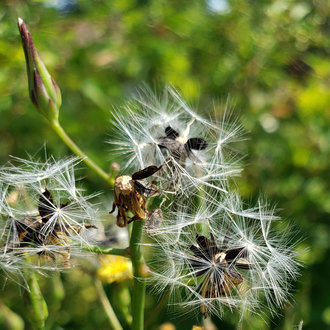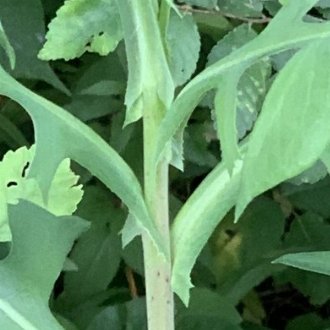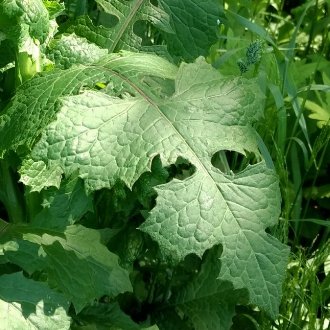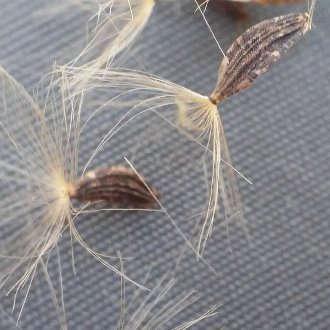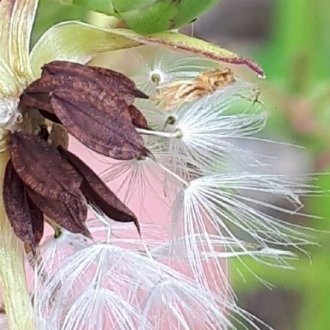Tall Blue Lettuce vs American Wild Lettuce
Lactuca species have notoriously variable leaf shapes. These species are often confused by people unfamiliar with them, but they are usually easy to tell apart, especially when they are blooming or making seeds. There is significant overlap in habitat, and plants can often be found growing side-by-side, but L. biennis is slightly more shade-tolerant and more restricted to partly-shaded, moister habitats, and more neutral soils, whereas L. canadensis ventures into drier, sunnier conditions, ranges much farther south, and is more tolerant of acidic soils. Because of variability, it is important to check multiple characteristics.
Tall Blue Lettuce (Lactuca biennis) | American Wild Lettuce (Lactuca canadensis) |
A tall biennial native to the more northerly parts of North America. | A tall biennial native to eastern North America, having expanded its range westward as well. |
Flowers usually pale blue, rarely white or pale yellow. Never a rich yellow. Flowerheads average more rays: usually 20–30, rarely as few as 15 or as many as 50 or more. Photo © bobkennedy, CC BY-SA 4.0. | Flowers a rich yellow color, rarely with reddish tinge or bluish. Flowerheads average fewer rays: usually 15-20, rarely more. Photo © Laura Costello, CC BY 4.0. |
Pappus (wispy part that carries seeds away in the wind) is tan, grayish, or light brown. Photo © Reuven Martin, Public Domain. | Pappus (wispy part that carries seeds away in the wind) is bright white. Photo © aarongunnar, CC BY 4.0. |
Leaves usually have a tapering, winged base, lacking lobes at the base, and not normally clasping the stem. Stem may or may not be glaucous (covered with a pale waxy coating) but foliage not usually glaucous. Photo © crgillette, CC BY 4.0. | Leaves often flare out at the base, with small lobes at the base, which often but not always clasp the stem. Stems usually glaucous and leaves often glaucous too. Photo © Sandy Wolkenberg, CC BY 4.0. |
Upper leaf surface is more textured, with depressed side-veins that often appear darker than the rest of the leaf surface. Leaf surface is not usually shiny. Photo © Mark Apgar, CC BY 4.0. | Upper leaf surface is flat and smooth, and often shiny. Side-veins are not depressed and often appear lighter than the rest of the leaf surface. Photo © Alex Zorach, CC BY 4.0. |
Pappus (wispy part) is attached directly to the body of the seed, without a separate stem. Seed usually has 5-6 veins, rarely 4, giving it a ridged look. Photo © Étienne Lacroix-Carignan, Public Domain. | Pappus is separated from the body of the seed by a long stem. Seed usually has 1 central vein, rarely up to 3. Photo © Jennifer Aitkens, CC BY 4.0. |
Involucres (clusters of bracts under each flowerhead) are usually 7-12mm, and are more bulb-shaped, with a spherical base and a more cylindrical tip coming to a blunter point. Photo © Tom Scavo, CC BY 4.0. | Involucres are usually 10-12mm, and taper more linearly to a sharper point, thus having a more conic shape over most of their length. Photo © M.B., CC BY 4.0. |
References & External Resources
These short lists show only links helpful for ID. For a complete list of references and resources also covering other aspects of ecology, visit the links section of the full article on each plant, which is the first entry here.






